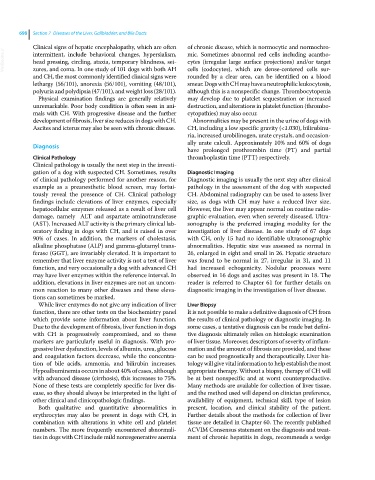Page 730 - Clinical Small Animal Internal Medicine
P. 730
698 Section 7 Diseases of the Liver, Gallbladder, and Bile Ducts
Clinical signs of hepatic encephalopathy, which are often of chronic disease, which is normocytic and normochro-
VetBooks.ir intermittent, include behavioral changes, hypersialism, mic. Sometimes abnormal red cells including acantho-
cytes (irregular large surface projections) and/or target
head pressing, circling, ataxia, temporary blindness, sei-
zures, and coma. In one study of 101 dogs with both AH
rounded by a clear area, can be identified on a blood
and CH, the most commonly identified clinical signs were cells (codocytes), which are dense‐centered cells sur-
lethargy (56/101), anorexia (56/101), vomiting (48/101), smear. Dogs with CH may have a neutrophilic leukocytosis,
polyuria and polydipsia (47/101), and weight loss (28/101). although this is a nonspecific change. Thrombocytopenia
Physical examination findings are generally relatively may develop due to platelet sequestration or increased
unremarkable. Poor body condition is often seen in ani- destruction, and alterations in platelet function (thrombo-
mals with CH. With progressive disease and the further cytopathies) may also occur.
development of fibrosis, liver size reduces in dogs with CH. Abnormalities may be present in the urine of dogs with
Ascites and icterus may also be seen with chronic disease. CH, including a low specific gravity (<1.030), bilirubinu-
ria, increased urobilinogen, urate crystals, and occasion-
ally urate calculi. Approximately 10% and 60% of dogs
Diagnosis
have prolonged prothrombin time (PT) and partial
Clinical Pathology thromboplastin time (PTT) respectively.
Clinical pathology is usually the next step in the investi-
gation of a dog with suspected CH. Sometimes, results Diagnostic Imaging
of clinical pathology performed for another reason, for Diagnostic imaging is usually the next step after clinical
example as a preanesthetic blood screen, may fortui- pathology in the assessment of the dog with suspected
tously reveal the presence of CH. Clinical pathology CH. Abdominal radiography can be used to assess liver
findings include elevations of liver enzymes, especially size, as dogs with CH may have a reduced liver size.
hepatocellular enzymes released as a result of liver cell However, the liver may appear normal on routine radio-
damage, namely ALT and aspartate aminotransferase graphic evaluation, even when severely diseased. Ultra-
(AST). Increased ALT activity is the primary clinical lab- sonography is the preferred imaging modality for the
oratory finding in dogs with CH, and is raised in over investigation of liver disease. In one study of 67 dogs
90% of cases. In addition, the markers of cholestasis, with CH, only 15 had no identifiable ultrasonographic
alkaline phosphatase (ALP) and gamma‐glutamyl trans- abnormalities. Hepatic size was assessed as normal in
ferase (GGT), are invariably elevated. It is important to 26, enlarged in eight and small in 26. Hepatic structure
remember that liver enzyme activity is not a test of liver was found to be normal in 27, irregular in 31, and 11
function, and very occasionally a dog with advanced CH had increased echogenicity. Nodular processes were
may have liver enzymes within the reference interval. In observed in 16 dogs and ascites was present in 18. The
addition, elevations in liver enzymes are not an uncom- reader is referred to Chapter 61 for further details on
mon reaction to many other diseases and these eleva- diagnostic imaging in the investigation of liver disease.
tions can sometimes be marked.
While liver enzymes do not give any indication of liver Liver Biopsy
function, there are other tests on the biochemistry panel It is not possible to make a definitive diagnosis of CH from
which provide some information about liver function. the results of clinical pathology or diagnostic imaging. In
Due to the development of fibrosis, liver function in dogs some cases, a tentative diagnosis can be made but defini-
with CH is progressively compromised, and so these tive diagnosis ultimately relies on histologic examination
markers are particularly useful in diagnosis. With pro- of liver tissue. Moreover, descriptors of severity of inflam-
gressive liver dysfunction, levels of albumin, urea, glucose mation and the amount of fibrosis are provided, and these
and coagulation factors decrease, while the concentra- can be used prognostically and therapeutically. Liver his-
tion of bile acids, ammonia, and bilirubin increases. tology will give vital information to help establish the most
Hypoalbuminemia occurs in about 40% of cases, although appropriate therapy. Without a biopsy, therapy of CH will
with advanced disease (cirrhosis), this increases to 75%. be at best nonspecific and at worst counterproductive.
None of these tests are completely specific for liver dis- Many methods are available for collection of liver tissue,
ease, so they should always be interpreted in the light of and the method used will depend on clinician preference,
other clinical and clinicopathologic findings. availability of equipment, technical skill, type of lesion
Both qualitative and quantitative abnormalities in present, location, and clinical stability of the patient.
erythrocytes may also be present in dogs with CH, in Further details about the methods for collection of liver
combination with alterations in white cell and platelet tissue are detailed in Chapter 60. The recently published
numbers. The more frequently encountered abnormali- ACVIM Consensus statement on the diagnosis and treat-
ties in dogs with CH include mild nonregenerative anemia ment of chronic hepatitis in dogs, recommends a wedge

